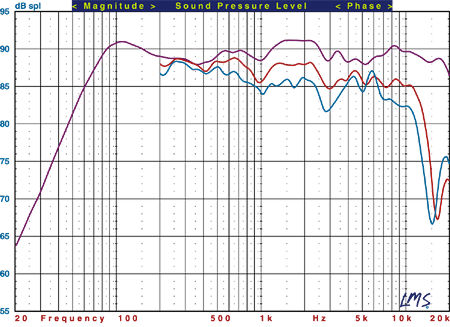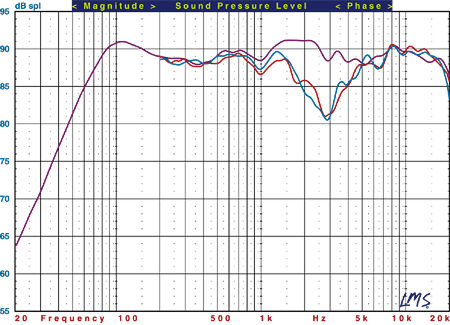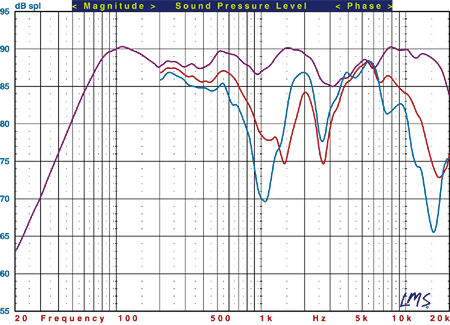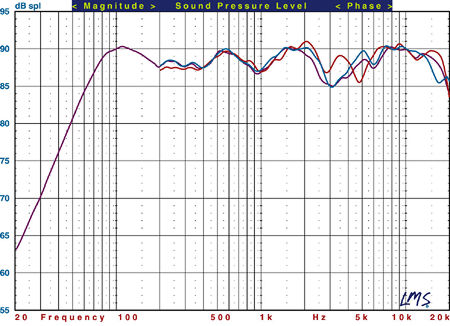Atlantic Technology System 6200 surround speaker system Measurements
All speaker measurements were taken at 1m with the speaker grilles removed, except as noted.
The Atlantic Technology 6200 LR's sealed enclosure was tuned to approximately 78Hz, and its sensitivity measured 90dB/W/m. The minimum impedance was 4.2ohms at 154Hz, and the specified nominal impedance of 6ohms is consistent with our results. The 6200 LR should be an easy load for any amplifier capable of driving a 4ohms load.
The frequency response of the 6200 LR (measured here without the 6200 PedWoofer) is shown in Fig.1 (violet). This is the pseudo-anechoic response averaged across a 30° forward angle (+/-15°) in the horizontal plane, combined with the nearfield responses of the woofers. The 6200 LR's averaged measured response is very smooth and flat, except for a slight, broad plateau centered at just under 2kHz. The audible result of this plateau should be minimal—enough to give the speaker a subtle immediacy without being in your face. This was consistent with the listening tests; the speaker is not laid-back, but there's no exaggeration in the presence region. The off-axis response also tracks the on-axis very well, subject to the usual high-frequency rolloff—of which there is noticeably less than we've measured from a number of more expensive speakers. The speaker's effective lower limit (–10dB) was 50Hz—it was, of course, designed to be used with a subwoofer.

Fig.1: Atlantic 6200 LR, pseudo-anechoic horizontal response at 45° (red) and 60° (blue) relative to tweeter axis, measured at tweeter height.
The vertical responses in Fig.2 are respectable, though the dip at 15° above and below the tweeter height suggests that there might be a slight loss of articulation through the presence band when listening below the tweeter axis—again, consistent with the subjective observations.

Fig.2: Atlantic 6200 LR, pseudo-anechoic vertical response at +15° (red) and –15° (blue) above and below tweeter axis.
The 6200 C center speaker's sealed cabinet is tuned to approximately 78Hz, and its impedance dips to a minimum of 4.1ohms at 154Hz. Its measured nominal impedance was 6ohms, its sensitivity 88dB/W/m, and its effective lower limit (–10dB) 48Hz. These results nearly duplicate those obtained from the 6200 LR.
The horizontal front response of the 6200 C, derived and averaged as for the 6200 LR, is shown in Fig.3 (violet). The on-axis average is relatively flat, though not quite as smooth as that of the 6200 LR. Overall, the response is +/-2.5dB from 75Hz to 20kHz. Things are not as tidy off-axis. Despite the tight clustering of the tweeter and woofers, we still see the deep suckouts at far-off-axis angles that characterize such designs. Not shown in Fig.3 is a very deep (–22dB) but narrow (about 1kHz wide at mid-depth) dip that crops up at 30° off-axis. It's centered at 2.4kHz—roughly the crossover frequency.

Fig.3: Atlantic 6200 C, pseudo-anechoic horizontal response at 45° (red) and 60° (blue) relative to tweeter forward axis.
No remedial steps we have ever seen—tight clustering, 21/2-way designs, whatever—mitigate the off-axis problems that show up with woofer-tweeter-woofer center-channel designs. This did not result in audible problems with the 6200 C in my room, in which no seat is more than 15° off-center. But I recommend that the seating area for this center-channel—and any similarly designed center speaker—be kept within +/-20° of the tweeter axis for best results.
There's nothing to complain about in the vertical off-axis measurements shown in Fig.4. As for the compensation switches on the back of the 6200 LR and C, the HF compensation switch in both speakers had a very subtle effect of +/-1dB above about 6kHz. The behind-screen compensation added about +2dB of lift from about 4kHz to the top of the range, and the boundary compensation control reduced the response in the 90–180Hz range by a maximum of 3dB. Replacing the grilles on the 6200 LR cut the response slightly in the 5.5–7kHz region, and again above 14kHz (1–1.5dB in both cases). Using the grille on the 6200 C reduced the response by 1–1.5dB above about 7kHz. In both cases the effect was subtle but, as the review suggests, audible to the critical listener.

Fig.4: Atlantic 6200 C, pseudo-anechoic vertical response at +15° (red) and –15° (blue) relative to tweeter forward axis.
Aside from the 6200 C's far-off-axis response—a common problem with 2- or 21/2-way center speakers—the Atlantic System 6200 produced a very respectable set of measurements.—TJN
Cornered!
For the separated subwoofer arrangement, I put the System 6200 PedWoofers in one corner, on adjacent walls with their cones as close together as possible and at a 90° angle to each other. (This does not put them 90° out of phase!) The 6200 LRs were placed on separate stands about 3 inches lower than the PedWoofers. Interestingly, this cured the tweeter-height issue and resulted in a balance that worked extremely well for music and movies—even with the grilles in place. I calibrated the parametric equalizer in the normal manner: using a basic RadioShack analog sound-level meter and the test CD supplied with the System 6200. Setup was tedious, but it took only about 30 minutes.
The response with the PedWoofers mounted in the corner was not quite as peak-free as it had been with them doubling as stands for the 6200 LRs, but it nevertheless fell within +/-4.5dB from 18 to 89Hz—a very good result for a typical domestic living room/home theater. The 1/12-octave analysis was not as impressive, but it never will be with a single parametric equalizer in most domestic rooms. But the improvement was definitely worthwhile, and a major step up from no EQ at all.—TJN





























































